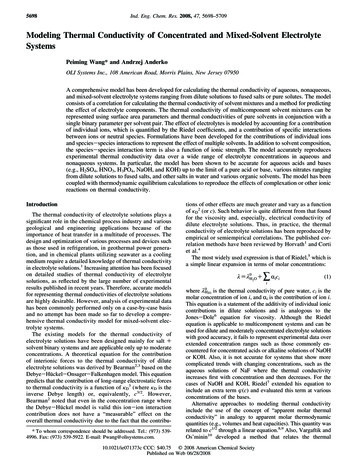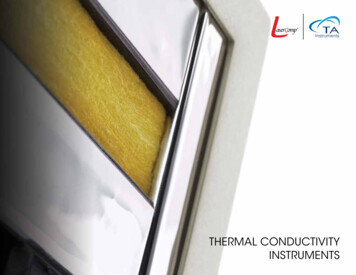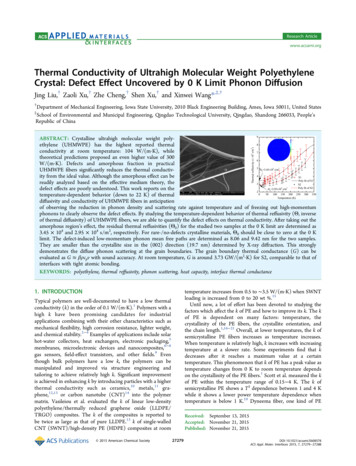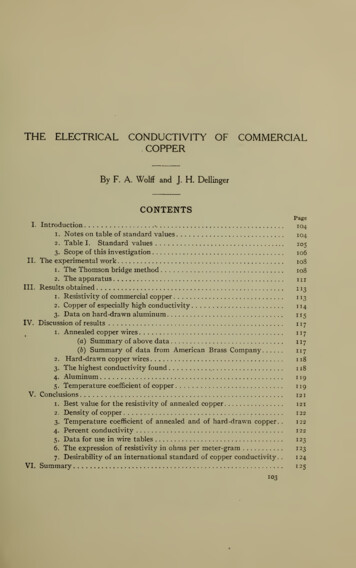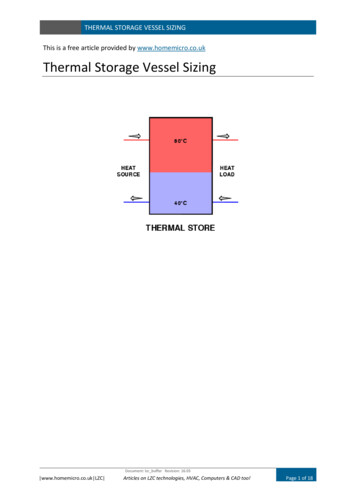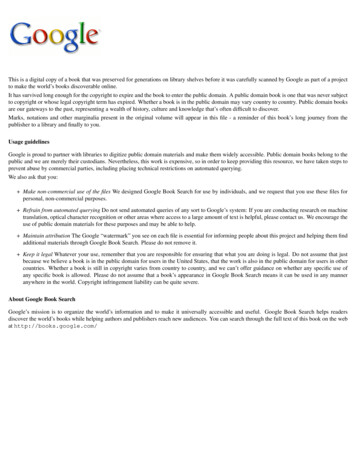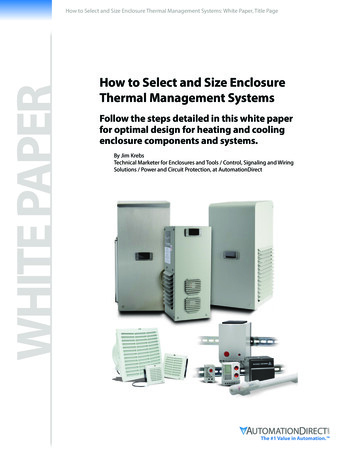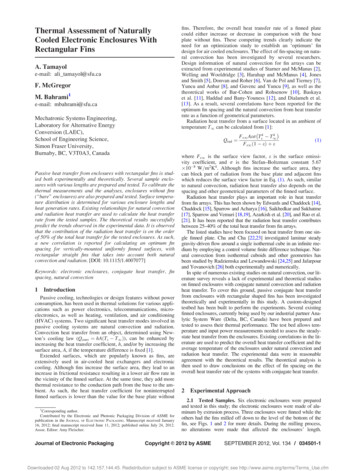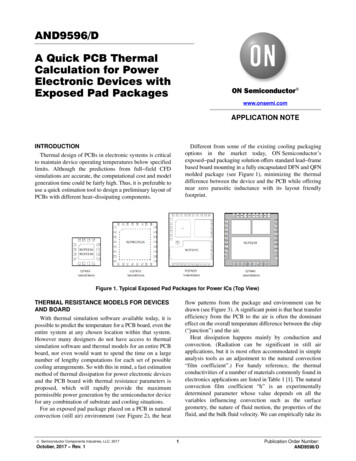
Transcription
International Journal of Engineering Research & Technology (IJERT)ISSN: 2278-0181Vol. 2 Issue 9, September - 2013Thermal Conductivity of Nanofluids-An Extensive Literature ReviewPurna Chandra MishraSchool of Mechanical EngineeringKIIT University, Bhubaneswar- 751024, Odisha,IndiaSantosh Kumar NayakSchool of Mechanical EngineeringKIIT University, Bhubaneswar- 751024, Odisha,IndiaIJERTSayantan MukherjeeSchool of Mechanical EngineeringKIIT University, Bhubaneswar- 751024, Odisha,IndiaNOMENCLATURE:𝛼 Ratio of the thermal conductivities of particleand base fluid.𝛿𝑇 Thickness of layer.ℎ Coefficient of heat transfer.𝑘𝑒𝑓𝑓 Effective thermal conductivity.𝑘𝑓 Thermal conductivity of base fluid.𝑘𝑛𝑎𝑛𝑜 Thermal conductivity of nanoparticle.𝑘𝑚 Thermal conductivity of base fluid.𝑛 Shape factor.𝜙 Particle volume fraction.𝑅𝑘 Kapitza resistance.𝑃𝑟 Prandtl No.𝑅𝑒 Reynolds No.IJERTV2IS90352www.ijert.org734
International Journal of Engineering Research & Technology (IJERT)ISSN: 2278-0181Vol. 2 Issue 9, September - 2013AbstractNanofluid, a new concept in nanotechnology hasalready got the attention of the researchcommunities all over the universe due to its uniqueproperties such as thermal conductivity. Numerousexperiments have been done on this particularproperty of nanofluids and still they are going on.Researchers have found the dependence of thermalconductivity of nanofluid on its material, shape,size, temperature, viscosity. Nanofluids applied invarious engineering fields critically require thesuitability of thermal conductivity particularly inheat transfer applications. Most of the previousworks are concentrated on the role of thermalconductivity in several application areas but a veryless information found on how the thermalconductivity of nanofluids can be determined eithertheoretically or experimentally. This articlepresents an extensive review on theoretical andexperimental works done on thermal conductivityof nanofluids.1. IntroductionNanofluid which is regarded as the most promisingtransport fluid for various scientific andengineering applications was first prepared by Choiet al. of Argonne National Lab. Nanofluids whichare preparedby mixing nanoparticles of various materials suchas Al, Cu, Al2O3, CuO, SiC, and CNT with the basefluids such as water, engine oil, ethylene glycol etc.High surface to volume ratio, less clogging,stability make such fluid suitable for heat transportin MEMS/NEMS, heat exchanger, and otherthermal applications. Authors have categorizednanofluids in many ways. Nanofluids can be of twokinds such as metallic nanofluids and nonmetallicnanofluids .Metallic nanofluids are prepared bydispersing nanoparticle made from metals such asaluminum ,copper, nickel etc. and non metallicnanoparticles are made by dispersing nanoparticlesof non metals i.e. metal oxides, various allotropesof carbon (Graphene, CNT)etc.Thermal conductivity signifies the inherent abilityof heat transfer and it is very important property forall thermal applications involving fluids. Heatconduction is depends upon thermal conductivity.Furthermore, Nusselt number, an importantparameter in convective heat transfer is directlyrelated to the thermal conductivity of fluids. Socomprehensive study of thermal conductivity ofIJERTV2IS903521.1Preparation of Nanofluids:Preparation of nanofluids is the first key step inexperimental studies with nanofluids. There areseveral techniques has been adopted for thepreparation of nanofluids. They can be broadlyclassified into two categories a) Two-step methodand b) One-step method.In two-step method first nanoparticles, nanofibres,nanotubes or other nanomaterials are first producedas powder by physical and chemical methods thenthey are dispersed into a fluid in the second stepwith the intense magnetic force agitation, ultrasonicagitation, high shear mixing etc. Presently two-stepmethod is adopted for the preparation of nanofluidsin industrial scale due to their cheap cost ofpreparation. Although this technique works goodfor oxide nanoparticles, it is ineffective for metalnanoparticles such as copper, Aluminum etc. due tohigh surface to volume ratio the nanoparticlesalways have a tendency to aggregate[1,2].One step method is of three kinds such as singlestep direct evaporation method, single-step physicalvapor condensation method and Vacuum-SANSS(Submerged arc nanoparticles synthesis) method.IJERTKey words: nanofluids, preparation, stability,thermal conductivitynanofluids is of paramount importance. Previousreports have described about the measurementmethods of thermal conductivity of nanofluids.Furthermore those also have given description onhow the various parameters such as shape, size,volume fraction and temperature of nanofluidsindividually affect the thermal conductivity ofnanofluids.The following part of this article gives a brief ideaabout preparation, stability, characterization andapplication of nanofluids with an intense focus onthe importanttheoretical as well experimentalstudies of thermal conductivity of nanofluid.Single-step direct evaporation approach wasdeveloped by Akoh et al. [3].The process is alsopopular as VEROS (Vacuum Evaporation onto aRunning Oil Substrate). Although the idea was toproduce nanoparticles but it was difficult toseparate nanoparticles from fluids [2].Eastman et al. developed single-step physical vaporcondensation method, in which simultaneousmixing and dispersing of particles occurs [4].Thismethod is suitable to prepare Cu/ethylene glycolnanofluid.Vacuum-SANSS (Submerged arc nanoparticlessynthesis) method handles undesired particleaggregation very well. This technique has beenemployed by Lo et al.(2005) to prepare Cu-basednanofluids with different dielectric liquids such asde-ionized water, with 30%, 50%, 70% volumesolutions of ethylene glycol and pure ethyleneglycol [5]. Recently, a Ni nano-magnetic fluid andsilver nanofluid were also produced by Lo et al.www.ijert.org735
International Journal of Engineering Research & Technology (IJERT)ISSN: 2278-0181Vol. 2 Issue 9, September - 2013(2006) using the SANSS method. The sphericalsilver nanoparticles formed in the ethylene glycoland the mean particle size is about 12.5 nm, whichmore closely resembles Newtonian fluids[1].In2009 Liang et al. Prepared a suspensionofTiO2nanoparticles of diameter of 65 nm using asubmerged electrode with a working temperature ofup to 6000 C.They found that the electric currentrequired for preparing the nanoparticle suspensionhad significant impact on the size, distribution andsurface sphericity of nanoparticles [6].1.2Stabilization of Nanofluids:IJERTThe agglomeration of nanoparticles results in notonly settlement and clogging but also thedecrement of thermal conductivity of nanofluids.So stability analysis is a matter of importance incontext to application of it. Stabilization ofnanofluids is mainly done by stability evolutionand stability enhancement.Sedimentation method, centrifugation method,spectral absorbency analysis and zeta potentialanalysis are the four basic methods which arerequired for evaluating stability of nanofluids.Sedimentation is a very simple method forevaluating the stability of nanoparticles in theirbase fluids. The sediment weight of nanoparticlesunder an external force is an indication of thecharacterized nanofluid. Zhu et al. [9] usedsedimentation balance method for the stability ofnanofluids. Centrifugal method is another method;developed to evaluate the stability of nanofluids[10].Singh et al. applied the centrifugationtechnique to observe the stability of silvernanofluid [11].The stability of nanofluids can be enhanced byadding suitable surfactants or by controlling pH orby ultra sonic agitation. Addition of surfactants canreduce the surface tension and increase particleimmersion. Several literatures have told aboutadding surfactant to nanofluids to avoid fastsedimentation. Several types of surfactants such asSodium dodecylsulfate (SDS)[73,74],Salt and 76,77],Dodecyl trimethylammonium bromide moniumbromide (HCTAB)[79], Polyvinylpyrrolidone(PVP)[80], Gum Arabic[81] have been utilized asstabilizing agents. But this technique cannot beapplicable for nanofluids working in hightemperature on account of probable damage ofbonding between surfactant and nanoparticle,causing hindrance to stability of nanofluids [9].Some researchers [15] reported above 60oC ascritical temperature by doing some experiments.pH control of nanofluids can increase stability.pHchange creates strong repulsive forces between theparticles and causes better agitation which internstabilizes the suspension .As an example, simpleacid treatment done by Xie et al.[16] caused nicestability of CNT in water .Lee et al. investigatedvarious pH values for Al2O3 nanofluid andobserved decrease or increment of agglomerationby changing pH [17]. It was found that optimizedpH value is different from one sample to another.For instance, suitable pH value for alumina, copperand graphite dispersed in water are around 8, 9.5and 2, respectively [18].Zeta potential analysis is also very important forstabilization of nanofluids. Zeta potential is thepotential difference between the dispersion mediumand the stationary layer of fluid attached to theparticle. The zeta potential indicates the degree ofrepulsion between adjacent, similarly chargedparticles in dispersion. For molecules and particlesthat are small enough, a high zeta potential willconfer stability. Nanofluids with zeta potentialfrom 40-60 mV are believed to have excellentstability. Zhu et al. [12] measured the zeta potentialof Alumina-water based nanofluids under differentpH values.Spectral absorbency analysis is a very efficient wayto evaluate the stability of nanofluids. In generalthere is a liner relationship between the absorbencyintensity and the concentration of the nanoparticlesin the fluids [13].For example. Huang et al.[14]found out the dispersion characteristics of Al andCususpensionusingtheconventionalsedimentation method with the help of absorbencyanalysis using a spectrophotometer after thesuspension deposited for 24 hours.IJERTV2IS90352After preparation of nanofluids, agglomerationmight occur over the time which results in fastsedimentation of nanoparticles due to enhancementof downward body force. Manson et al. [19]investigated two different nanofluids; carbonblack/water and silver/silicon oil and they utilizedhigh energy of cavitations for breaking clustersamong particles.As it was mentioned before, all three methodsmight be used for one specific sample duringsynthesis and preparation; yet, it is difficult tomake stable nanofluid and rare to maintainnanofluids synthesized by the traditional methodsin a homogeneous stable state for more than 24 h[20].1.3Particle Size Characterization:Structural characterization is a very important partfor the study of nanomaterials as the structuralproperties has a direct impact on the mechanical,thermal chemical, electrical properties of materials.X-Ray diffraction technique is the fundamentaltechnique to examine the crystal structure ofnanomaterials. It helps to obtaining informationssuch as lattice parameter, crystal structure, samplewww.ijert.org736
International Journal of Engineering Research & Technology (IJERT)ISSN: 2278-0181Vol. 2 Issue 9, September - 2013orientation, and particle size of nanomaterials.Optical spectroscopy uses the interaction of lightwith matter as a function of wavelength or energyin order to obtain information about the material.Optical spectroscopy is attractive for materialscharacterization because it is fast, nondestructiveand of high resolution.Raman Spectroscopy process is used to describethe excitation of vibration modes (phonons) in thesample using light. Raman spectroscopy has beenused to characterize the carbon nanotubes.Transmission Electron Microscopy (TEM) andScanning Electron Microscope (SEM) are reckonedas the most important tools to determine the size,distribution and the morphology of the synthesizednanoparticles. They use electron beam to create theimage of samples.Another method named, DSL (Dynamic lightScattering) technique is used by several researchersfor measuring particle size distribution [68].2. Thermal Conductivity of Nanofluids:Where 𝑛 is the shape factor .Here 𝑛 3/𝜓 and𝜓is the particle sphericity, defined as the ratio ofthe surface area of a sphere with the same volumeas the particle equal to the surface area of theparticle.Another expression, presented by Davis [23] isapplied to spherical suspensions and given by:keffkf3( 1) 3[ f 2 0 ] 2 ( 1) Hesselman and Johnson [24] derived an expressionfor the effective thermal conductivity ofcomposites, taking into account the thermal barrierresistance at the interface between the materials andthe relations for spherical, cylindrical and flat platefor low concentration of dispersion. The resultingexpression for spherical particles can be arrangedas: 1 2 2 2 [ 1 1] kf 1 2 2 [ 1 1]2.1Theoretical Models:keffIJERTMaxwell was the first who analytically investigatedthe thermal conductivity of an colloid solution .Hisinvestigation led him to generate an mathematicalmodel which is famous as Maxwell’s Equation[21].This model is applicable to homogeneous andlow-volume fraction liquid -solid suspension withrandomly dispersed, uniformly sized and noninteracting spherical particles. The Maxwellequation is: keffkf Where 𝛽 𝑅𝑘 𝑘𝑚 /𝑘𝑛𝑎𝑛𝑜 and 𝑅𝑘 is the Kapitzaresistance.Hasselman and Johnson found that theeffective thermal conductivity depends upon thevolume fraction of the dispersed phase as well asthe dispersion size.Newer models have been developed in the past fewyears .This models are nothing but the modifiedversions of the old models Like Maxwell modeland H-C model.3( 1) 2 ( 1) 𝑘𝑒𝑓 𝑓 Is the effective thermal conductivity of solid-liquid
Thermal conductivity signifies the inherent ability of heat transfer and it is very important property for all thermal applications involving fluids. Heat conduction is depends upon thermal conductivity. Furthermore, Nusselt number, an important parameter in convective heat transfer is directly related to the thermal conductivity of fluids. So comprehensive study of thermal conductivity of .
